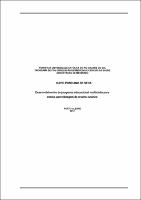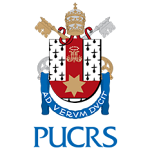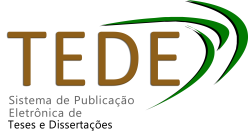| Share record |


|
Please use this identifier to cite or link to this item:
https://tede2.pucrs.br/tede2/handle/tede/1689| Document type: | Dissertação |
| Title: | Desenvolvimento de programa educacional multimídia para ensino-aprendizagem de retalho cutâneo |
| Author: | Sena, David Ponciano de  |
| Advisor: | Silva, Vinícius Duval da |
| Abstract (native): | Introdução: Durante o processo de ensino e aprendizagem em cirurgia, deve-se levar em conta a necessidade de oferecer metodologia de ensino e treinamento eficientes, de fácil acesso e com boa relação custo-benefício, evitando conflitos éticos em relação aos pacientes e modelos animais. O objetivo desse estudo é desenvolver e validar um software multimídia que auxilie no processo de ensino-aprendizagem do retalho rombóide. Método: 50 alunos voluntários do quinto e sexto anos do curso de medicina responderam a um pré-teste e foram randomicamente divididos em dois grupos de 25 alunos cada, o grupo controle foi exposto um capítulo de livro impresso, enquanto o grupo teste utilizou um software multimídia, descrevendo como realizar um retalho rombóide. Cada grupo confeccionou um retalho em modelo artificial de treinamento(bench model) sendo avaliado de forma cega por cirurgiões membros da SBCP (Sociedade Brasileira de Cirurgia Plástica) através do protocolo OSATS (Objective Structured Assessment of Technical Skill) e respondeu a um pós-teste. O grupo controle foi retestado num segundo momento utilizando o software. Resultados: Houve uma superioridade quanto ao desempenho do grupo software multimídia confirmada pelos resultados da lista de checagem (p < 0,002), avaliação geral global (p = 0,017) e pós-teste (p < 0,001). Conclusões: Alunos que utilizam CAL apresentam melhor desempenho subjetivo e objetivo na confecção de retalhos rombóides, bem como a classificaram como a melhor ferramenta de estudo. |
| Abstract (english): | During the process of teaching and learning in surgery one should take into account the need to provide adequate teaching methodology, that is efficient, accessible and provides good cost-benefit training, also avoiding ethical conflicts with patients and animal models. The goal of this study is to develop and validate a multimedia software that assists in the teaching-learning rhomboid flap process. Fifty students from the fifth and sixth year of medical school completed a pretest and were randomly divided into two groups of 25 students each. For five minutes the control group studied a printed chapter of a standard book while the test group used a computer multimedia software, describing how to perform a rhomboid flap. Each group was evaluated in a blind manner by board certified surgeons (Brazilian Society of Plastic Surgery) using OSATS protocol (Objective Structured Assessment of Technical Skill) and answered a post-test. The control group was assessed a second time after studying for 5 minutes with the software. The group that used the multimedia software achieved higher scores on the practical performance and the post-test as compared to the control group. All students subjected to both methods rated the software as their choice method of learning. |
| Keywords: | MEDICINA PROCEDIMENTOS CIRÚRGICOS RECONSTRUTIVOS CIRURGIA PLÁSTICA PROCEDIMENTOS CIRÚRGICOS AMBULATÓRIOS EDUCAÇÃO MÉDICA TECNOLOGIA EDUCACIONAL |
| CNPQ Knowledge Areas: | CNPQ::CIENCIAS DA SAUDE::MEDICINA |
| Language: | por |
| Country: | BR |
| Publisher: | Pontifícia Universidade Católica do Rio Grande do Sul |
| Institution Acronym: | PUCRS |
| Department: | Faculdade de Medicina |
| Program: | Programa de Pós-Graduação em Medicina e Ciências da Saúde |
| Citation: | SENA, David Ponciano de. Desenvolvimento de programa educacional multimídia para ensino-aprendizagem de retalho cutâneo. 2012. 86 f. Dissertação (Mestrado em Medicina e Ciências da Saúde) - Pontifícia Universidade Católica do Rio Grande do Sul, Porto Alegre, 2012. |
| Access type: | Acesso Aberto |
| URI: | http://tede2.pucrs.br/tede2/handle/tede/1689 |
| Issue Date: | 28-Mar-2012 |
| Appears in Collections: | Programa de Pós-Graduação em Medicina e Ciências da Saúde |
Files in This Item:
| File | Description | Size | Format | |
|---|---|---|---|---|
| 438344.pdf | Texto Completo | 1.35 MB | Adobe PDF |  Download/Open Preview |
Items in DSpace are protected by copyright, with all rights reserved, unless otherwise indicated.




